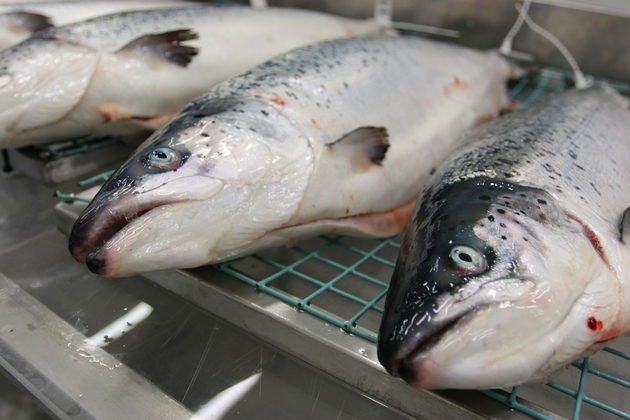
Traditional salmon farming practices heavily rely on fish oil as a source of omega-3 fatty acids, particularly eicosapentaenoic acid (EPA) and docosahexaenoic acid (DHA), for feeding salmon.
However, there is growing concern about the sustainability of fish oil production. The industry has significantly increased its reliance on fish oil to meet the increasing demand for salmon aquaculture. This has put pressure on wild fish populations, raising environmental concerns.
A new study by scientists from Vitapro Chile and the Institute of Aquaculture at the Austral University of Chile investigated the impact of completely replacing fish oil (FO) in the diet of Atlantic salmon (Salmo salar) with alternative sources (oil from the microalga Schizochytrium sp. and genetically modified canola oil) during their marine growth phase. The focus was on the growth of the fish from 400 grams to 4 kilograms.
Sustainable Alternatives
Researchers worldwide are exploring alternative and more sustainable sources of omega-3 for feeding various aquaculture species, particularly salmon. Two promising options are:
- Algae Oil: This oil is derived from the microalga Schizochytrium sp., a renewable resource that can be produced in large quantities without harming marine ecosystems. Some companies are at the forefront of developing and producing high-quality algae oil rich in EPA and DHA for aquaculture. Schizochytrium sp. microalgae oil has demonstrated its potential in feeding shrimp larvae, juvenile tilapia, and improving the quality of tilapia fillets.
- Genetically Modified (GM) Canola Oil: Canola is a common crop, and scientists have developed transgenic varieties that can produce EPA and DHA. Various studies have reported the potential of canola oil to replace fish oil in feeds for juvenile salmon.
The Research
The researchers compared three fishmeal-free diets, each containing 2.2% EPA+DHA from different sources:
- Control: Standard fish oil diet.
- Can n-3: Diet containing genetically modified canola oil rich in EPA+DHA.
- AOV: Diet containing oil from the microalga Schizochytrium sp., another source of EPA+DHA.
Key Findings
The fish were raised in controlled tanks with identical water temperature, lighting, and feeding schedules. The researchers monitored the fish throughout the experiment and evaluated:
- Growth and Health: No significant differences were found in growth rate or liver health among the three diets.
- EPA+DHA Retention: The fish effectively absorbed and retained EPA+DHA from all three diets, with similar levels in their bodies and fillets.
- Stress Response: When subjected to stress, fish from all groups showed similar responses in terms of key physiological indicators.
- Fillet Quality: While the overall quality was comparable, sensory analysis revealed some minor differences in aroma and flavor among the groups. Fish fed with Can n-3 had a slightly weaker overall aroma, while those fed with AOV had lower scores in aroma, oiliness, and fresh salmon flavor.
- Nutritional Profile: Interestingly, the fatty acid profile of fish fed Can n-3 and AOV diets showed potentially more favorable human health characteristics than the fish oil group. This was observed in specific indicators such as the ratio of polyunsaturated to saturated fatty acids (PUFA/SFA), the thrombogenicity index (risk of blood clot formation), and the health-promoting index.
Advantages of Alternative Omega-3 Sources
Alternative omega-3 sources offer several advantages over traditional fish oil:
- Sustainability: They help reduce pressure on wild fish populations, promoting environmentally friendly aquaculture practices.
- Scalability: They can be produced in large quantities to meet the growing demand for omega-3 in salmon farming.
- Product Quality: Studies suggest that salmon fed with alternative omega-3 sources can maintain similar physiological performance, stress response, and final product quality to those fed with fish oil.
What This Means for the Salmon Industry
This study demonstrates that completely replacing fish oil in salmon diets with sustainable alternatives like genetically modified canola oil or microalgae oil is possible without compromising the growth, health, or overall quality of the final fish product. In fact, the study suggests that salmon raised with these alternative feeds could even offer some health benefits to consumers.
Some important considerations:
- Consumer Acceptance: While research suggests that salmon fed with alternative omega-3 sources maintains good quality, consumer acceptance of these new methods is crucial.
- Regulatory Approval: Regulatory frameworks need to be adapted to ensure the safety and transparency of these alternative feed sources.
Overall, exploring alternative omega-3 sources for salmon aquaculture represents a significant step towards a more sustainable and healthy future. The study was funded by Vitapro Chile.
Contact
Tomás Pablo Leyton
Centro Experimental Acuícola, CEA, Vitapro Chile
Ruta 5 sur km 1170, P.O. Box 339, Castro, Chile
Email: tleytonm@vitapro.cl
Ana Farías
Instituto de Acuicultura, Universidad Austral de Chile
Av. Los Pinos s/n Balneario Pelluco, P.O. Box 1327, Puerto Montt, Chile
Email: afarias@uach.cl
Reference
Leyton, T. P., Marín, S., Castillo, S., Sánchez, R., Collipal, R., Madrid, J., & Farías, A. (2024). Long-term substitution of fish oil with alternative sources in Atlantic salmon (Salmo salar): Performance, health, and consumer appeal. Aquaculture, 590, 741073. https://doi.org/10.1016/j.aquaculture.2024.741073
Editor at the digital magazine AquaHoy. He holds a degree in Aquaculture Biology from the National University of Santa (UNS) and a Master’s degree in Science and Innovation Management from the Polytechnic University of Valencia, with postgraduate diplomas in Business Innovation and Innovation Management. He possesses extensive experience in the aquaculture and fisheries sector, having led the Fisheries Innovation Unit of the National Program for Innovation in Fisheries and Aquaculture (PNIPA). He has served as a senior consultant in technology watch, an innovation project formulator and advisor, and a lecturer at UNS. He is a member of the Peruvian College of Biologists and was recognized by the World Aquaculture Society (WAS) in 2016 for his contribution to aquaculture.
